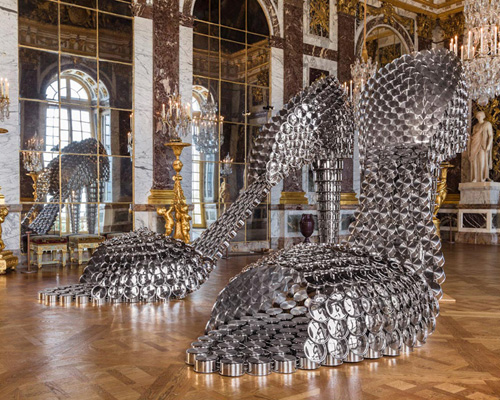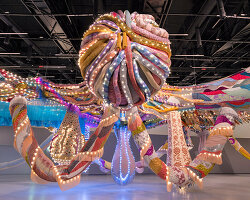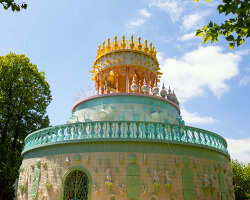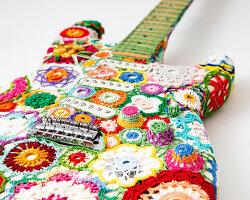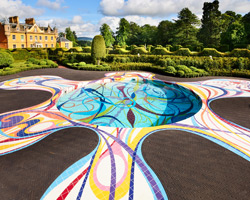galerie des glaces ‘marilyn (PA)’, 2011 stainless steel pans and lids, concrete (2x) 290 x 157 x 410cm collection of the artist; courtesy galerie nathalie obadia, paris/brussels and haunch of venison, london work produced with the support of silampos
joana vaconcelos versailles palace of versailles, france june 18th to september 30th, 2012
paris-born lisbon-based artist joana vasconcelos is currently taking over the palace of versailles in france with her large sculptural works as part of the château’s annual contemporary art exhibition.
installed within the state apartments and gardens of the expansive property, vasconcelos’ work creates a dialogue dealing with contemporary idiosyncrasies, where the dichotomies of hand-crafted / industrial, private / public, tradition / modernity and popular culture / erudite culture are imbued with affinities apt to renovate the usual fluxes of signification which are characteristic of contemporaneity.
‘my work has developed around the idea that the world is an opera, and versailles embodies the operatic and aesthetic ideal that inspires me. the works that I propose exist for this place. I see them as linked to versailles in a timeless way. when I stroll through the rooms of the palace and its gardens, I feel the energy of a setting that gravitates between reality and dreams, the everyday and magic, the festive and the tragic. I can still hear the echo of the footsteps of marie-antoinette, and the music and festive ambiance of the stately rooms. how would the life of versailles look if this exuberant and grandiose universe was transferred to our period?
interpreting the dense mythology of versailles, transporting it into the contemporary world, and evoking the presence of the important female figures that have lived here, while drawing on my identity and my experience as a portuguese woman born in france, will certainly be the most fascinating challenge of my career.’ – joana vasconcelos
the south end of the the palace’s ‘hall of mirrors’ where ceremonies and important events in the history of france were staged, hosts ‘marilyn’, a pair of high-heeled sandals constructed from the repeated arrangement of stainless steel pans and lids. the mammoth-scale high heels, standing within this vast hall, creates a gulliver effect, and are an ode to women’s achievements both on public and private spheres. the selected medium of which the shoes are made are a reference to the armours of the warriors who fought in the dutch war (1672-1678) and in the war of devolution (1667-1668). charles le brun’s subject matters for his ceiling paintings and medallions – and the mirrors that decorate the arcade team up in a disconcerting game of reflections, multiplying the space ad infinitum. the sandals refers the visitor to the accomplishments of the absent female figure, as grandiose as the glories celebrated by louis XIV through the paintings of le brun, reflected on the cold metallic surface of ‘marilyn’.
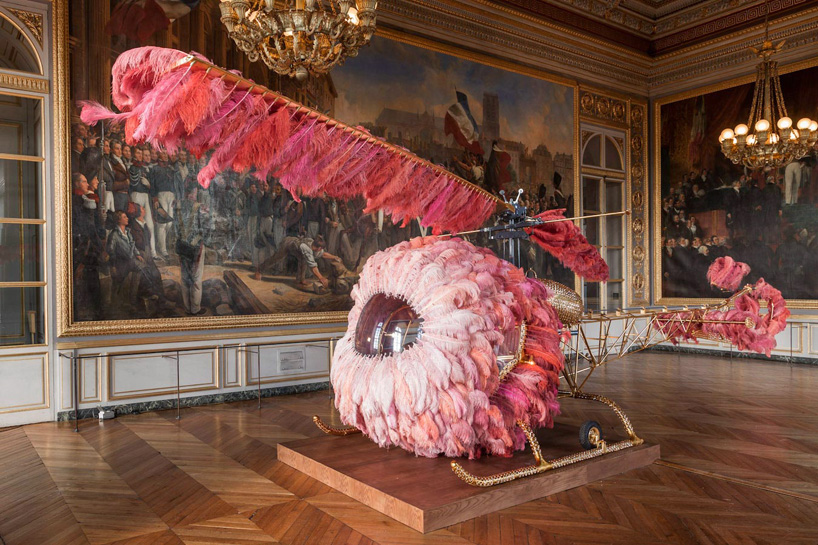 salle 1830 ‘lilcoptère’, 2012 bell 47 helicopter, ostrich feathers, swarovski crystals, gold leaf, industrial coating, dyed leather upholstery embossed with fine gold, arraiolos rugs, walnut wood, wood grain painting, passementerie 300 x 274 x 1265 cm collection of the artist; courtesy galerie nathalie obadia, paris/brussels and haunch of venison, london work produced in collaboration with fundação ricardo do espírito santo silva, lisbon
salle 1830 ‘lilcoptère’, 2012 bell 47 helicopter, ostrich feathers, swarovski crystals, gold leaf, industrial coating, dyed leather upholstery embossed with fine gold, arraiolos rugs, walnut wood, wood grain painting, passementerie 300 x 274 x 1265 cm collection of the artist; courtesy galerie nathalie obadia, paris/brussels and haunch of venison, london work produced in collaboration with fundação ricardo do espírito santo silva, lisbon
‘lilicoptère’ is a helicopter that has been decorated in the same vein as versaille’s aesthetic universe, covered in gold leaf with thousands of rhinestones embedded on its exterior. the cockpit and blades seem to have been invaded by an extravagant and colourful coat of ostrich feathers that have been dyed in hues of salmon, pink and orange.
sitting within salle 1830, a featherless gap at the front of the cockpit reveals an interior which features carved wooden surfaces, gildings and embroidered upholstery emblazoned with marie-antoinette’s monogram – simultaneously an anachronistic microcosmos and a time-machine that transports the queen into our current day. the detailed work makes use of the rich, glamorous and refined aesthetics of the ancien régime’s royalty, suggesting not only machine metamorphosing into animal, but also the return to the origins that have led man to realize his dream of flying.
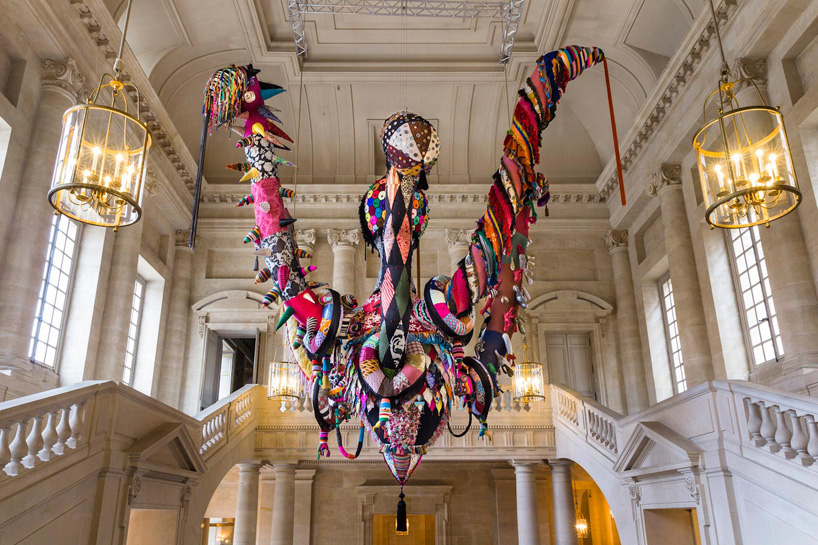 escalier gabriel ‘mary poppins’, 2012 handmade woollen knitting and crochet, industrial knitted fabric, fabrics, ornaments, polyester, steel cables 700 x 600 x 600 cm collection of the artist; courtesy galerie nathalie obadia, paris/brussels and haunch of venison, london
escalier gabriel ‘mary poppins’, 2012 handmade woollen knitting and crochet, industrial knitted fabric, fabrics, ornaments, polyester, steel cables 700 x 600 x 600 cm collection of the artist; courtesy galerie nathalie obadia, paris/brussels and haunch of venison, london
‘mary poppins’ hanging above the escalier gabriel, is a tentacular body that is formed from an unlikely combination of both industrial and handmade textiles. the piece is part of the artist’s ‘valkyries series’ which visitors encounter again within the galerie des batailles. with six protective arms extending from its body, the variety of ornaments and different textures of the chandelier-like piece results in unexpected organic forms, the entire ‘valkyries series’ contrasting the crisp neoclassicism of its surroundings.
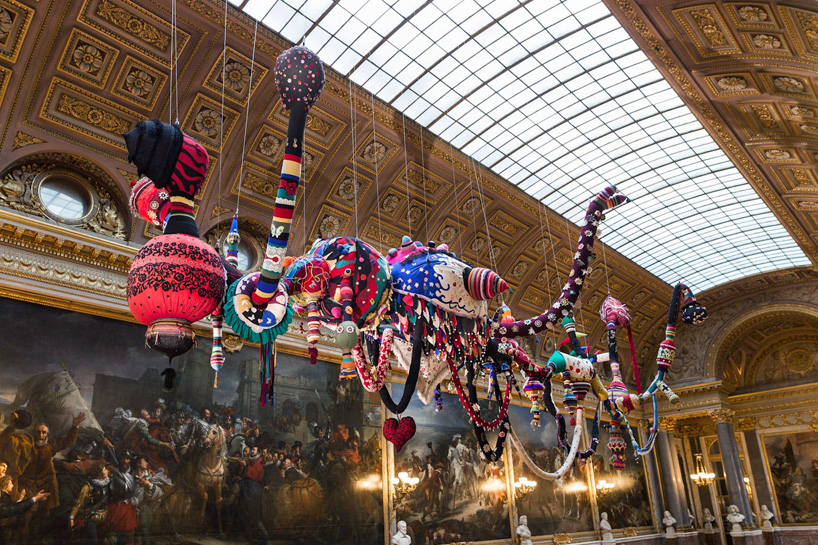 galerie des batailles ‘valquíria enxoval’, 2009 [valkyrie trousseau] drawn-thread work and other embroideries, felt appliqués, bobbin lace, tatting, quartz-decorated pottery, handmade woollen knitting and crochet, fabrics, ornaments, polyester, steel cables 400 x 530 x 1400 cm câmara municipal de nisa, nisa work produced in collaboration with the artisans of nisa
galerie des batailles ‘valquíria enxoval’, 2009 [valkyrie trousseau] drawn-thread work and other embroideries, felt appliqués, bobbin lace, tatting, quartz-decorated pottery, handmade woollen knitting and crochet, fabrics, ornaments, polyester, steel cables 400 x 530 x 1400 cm câmara municipal de nisa, nisa work produced in collaboration with the artisans of nisa
hovering over the grandiose galerie des batailles, where louis-philippe I intended to stage ‘a grand overview’ of france’s military history, is vasconcelos’ ‘valkyries’ series. the vibrancy of these forms the three individual works carry different universes within themselves, confronting the military theme – the rational, symmetrical organization – of the room in which they are installed with strangeness, expressing a hint of sensualism and hedonism in their appearance: ‘royal valkyrie’ revisits and reinterprets the style of the palace of versailles by retrieving the luxury and the exuberance of floral brocades. ‘golden valkyrie’ references gold, bringing together the sheen of lavish gold fabrics with more ordinary industrially made textiles. ‘valquíria enxoval’ hints at rural aesthetics, featuring colours, motifs and techniques that are typically found in the small portuguese countryside village of nisa, which is known for its rich history of arts and crafts.
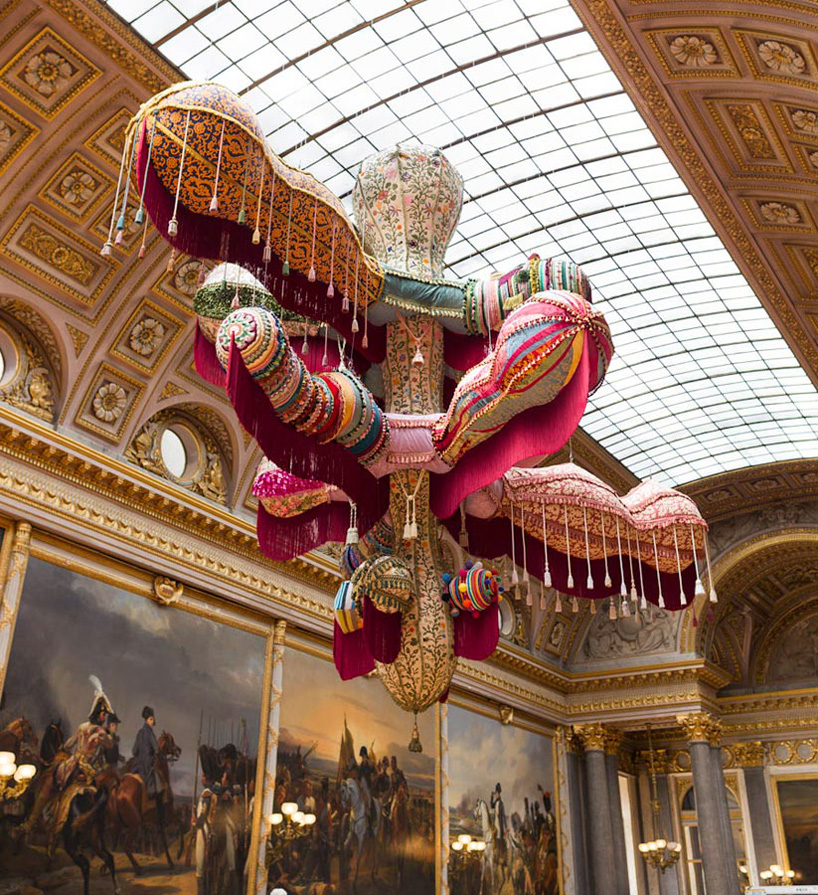 galerie des batailles ‘royal valkyrie’, 2012 handmade woollen crochet, industrial knitted fabric, fabrics, ornaments, polyester, steel cables dimensions variable collection of the artist; courtesy galerie nathalie obadia, paris/brussels and haunch of venison, london work produced in collaboration with the artisans of nisa and with the support of manufacture prelle, paris
galerie des batailles ‘royal valkyrie’, 2012 handmade woollen crochet, industrial knitted fabric, fabrics, ornaments, polyester, steel cables dimensions variable collection of the artist; courtesy galerie nathalie obadia, paris/brussels and haunch of venison, london work produced in collaboration with the artisans of nisa and with the support of manufacture prelle, paris
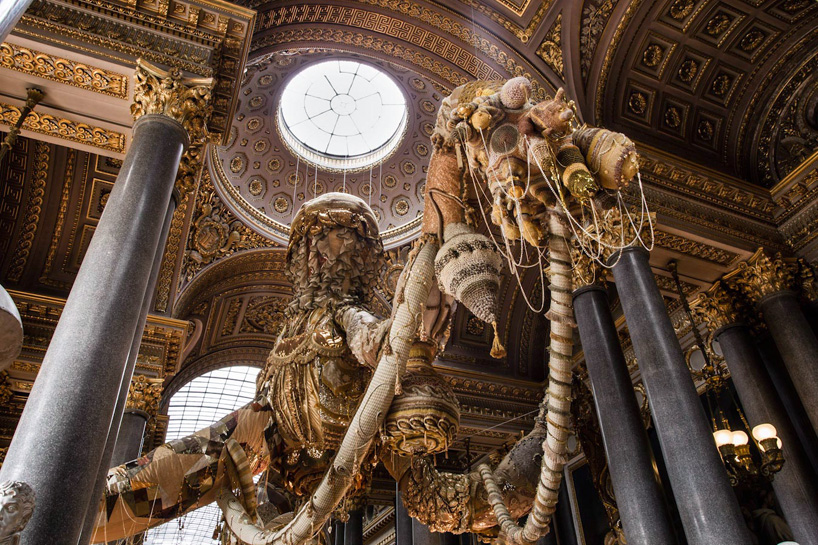 galerie des batailles ‘golden valkyrie’, 2012 handmade woollen crochet, industrial knitted fabric, fabrics, ornaments, polyester, steel cables 650 x 1140 x 1360 cm collection of the artist; courtesy galerie nathalie obadia, paris/brussels and haunch of venison, london
galerie des batailles ‘golden valkyrie’, 2012 handmade woollen crochet, industrial knitted fabric, fabrics, ornaments, polyester, steel cables 650 x 1140 x 1360 cm collection of the artist; courtesy galerie nathalie obadia, paris/brussels and haunch of venison, london
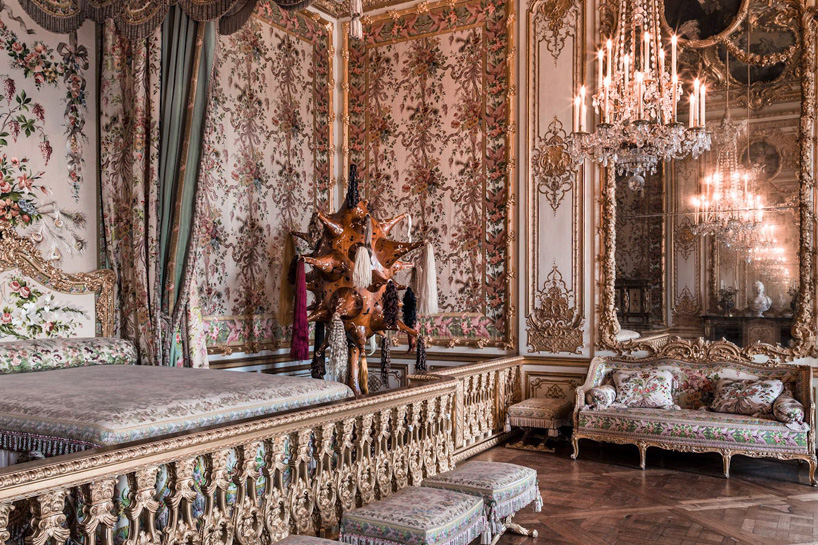 chambre de la reine ‘perruque’, 2012 vinhatico, ebony inlays, gold-plated brass, shellac, beeswax, artificial hair, iron 298 x ø 124 cm | base: ø 105 cm fundação ricardo do espírito santo silva, lisbon work produced in collaboration with fundação ricardo do espírito santo silva, lisbon
chambre de la reine ‘perruque’, 2012 vinhatico, ebony inlays, gold-plated brass, shellac, beeswax, artificial hair, iron 298 x ø 124 cm | base: ø 105 cm fundação ricardo do espírito santo silva, lisbon work produced in collaboration with fundação ricardo do espírito santo silva, lisbon
the chambre de la reine is where marie leszczinska’s and marie-antoinette’s decorative tastes can still be witnessed. here one finds ‘perruque’, a uterine-shaped object standing in the corner of the salle. made from vinhatico, combined with tresses of artificial hair – drawing from the exuberance of the hairstyles that once flaunted versailles – the sculpture is decorated with fine ebony inlays and golden metal appliques, reminiscent of portuguese and french furniture and vaguely evocative of fabergé eggs – alluding to the birth of the nineteen infants (among which louis XV and louis XVI) that took place in this bedchamber. exhibiting conical protuberances leaking cotton candy-like strings of blond hair, ‘perruque’ proposes the absurd and the surreal in a grotesque yet seducing sculpture-wig-furniture piece.
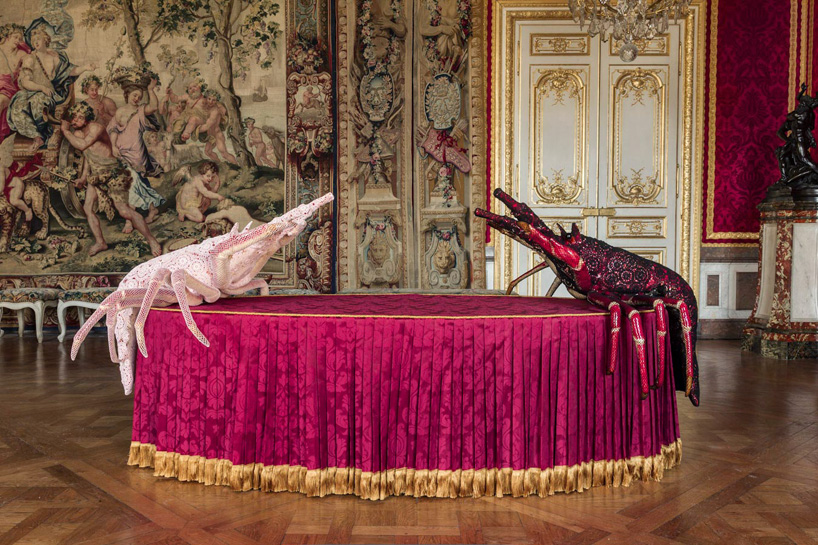 antichambre du grand couvert ‘le dauphin’ and ‘la dauphine’, 2012 rafael bordalo pinheiro faiences painted with ceramic glaze, azores crocheted lace (2x) 84 x 125 x 140 cm collection of the artist; courtesy galerie nathalie obadia, paris/brussels and haunch of venison, london
antichambre du grand couvert ‘le dauphin’ and ‘la dauphine’, 2012 rafael bordalo pinheiro faiences painted with ceramic glaze, azores crocheted lace (2x) 84 x 125 x 140 cm collection of the artist; courtesy galerie nathalie obadia, paris/brussels and haunch of venison, london
two large ceramic lobsters comprise ‘le dauphin’ and ‘la dauphine’ which are positioned to appear as if they are awaiting the monarchs’ arrival at the antechamber of the grand couvert, where the royal meal is to be served. placed face to face, bedecked in delicate crochet laces, the longlingly gaze at one another as if they were lovers. undisturbed by the turmoil in the war depictions decorating the ceiling of the room, the couple demonstrate, as pointed out by dali regarding his lobster telephone, that sexual desire and gastronomy go hand in hand. this work is comprised from a limited group of faiance pieces designed by rafael bordalo pinheiro who was one of the most highly acknowledged portuguese artists of the 19th century. the work challenges the usual signification fluxes that circulate between high culture, tradition and modernity.
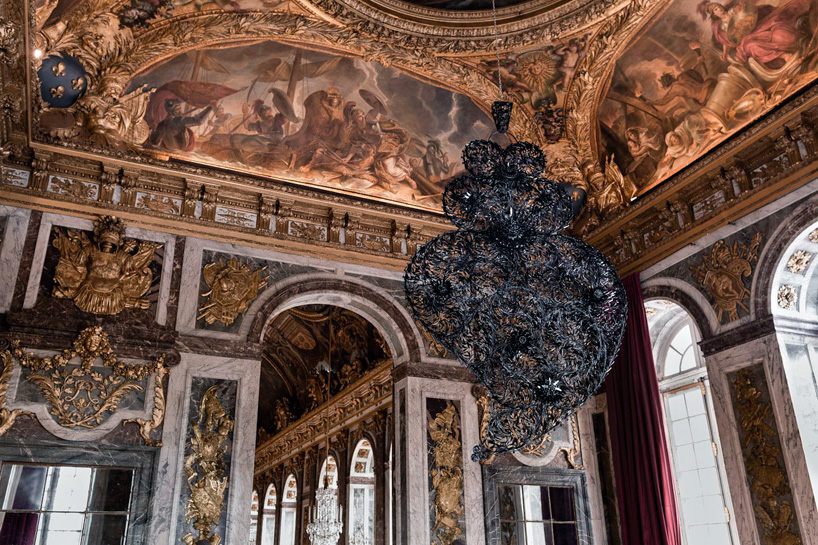 salon de la guerre ‘coração independente preto’, 2006 [black independent heart] opaque black plastic cutlery, painted iron, metal chain, motor, sound installation songs performed by amália rodrigues: estranha forma de vida [strange way of life] (alfredo rodrigo duarte/amália rodrigues), maldição [curse] (joaquim campos da silva/armando vieira pinto), gaivota [seagull] (alain oulman/alexandre o’neill). authorized by iplay – som e imagem / (p) valentim de carvalho. 382 x 222 x 70 cm musac – museo de arte contemporáneo de castilla y león, león
salon de la guerre ‘coração independente preto’, 2006 [black independent heart] opaque black plastic cutlery, painted iron, metal chain, motor, sound installation songs performed by amália rodrigues: estranha forma de vida [strange way of life] (alfredo rodrigo duarte/amália rodrigues), maldição [curse] (joaquim campos da silva/armando vieira pinto), gaivota [seagull] (alain oulman/alexandre o’neill). authorized by iplay – som e imagem / (p) valentim de carvalho. 382 x 222 x 70 cm musac – museo de arte contemporáneo de castilla y león, león
the artist’s ‘red’ and ‘black independent heart’ are hung from the ceiling on either side of the hall of mirrors; the former, in the peace salon; the latter, in the war salon. the dangling masses are replications of the heart of viana – the iconic portuguese jewellery piece – whose colors resonate passion and death, war and peace. from their respective axes, the hearts rotate, evoking the cycles of life and of the eternal return. approaching the ornate pieces, one discovers they are in fact constructed from plastic cutlery, a trompe-lœil that echoes the virtuosity of the masters of the grand siècle.
musical referents have a strong presence in the installation – – the works are usually accompanied by three meaningful fados interpreted by amália rodrigues, diva of portuguese music – recall the concerts offered by marie leszczynska in the peace salon and the important role they played in the musical life of versailles.
an emotive installation of sound and movement, ‘independent heart’ is a powerful diptych dedicated to passion and death (recurring themes on fado’s lyrics), which intersect and dialogue with the themes of peace and war, present on the eloquent paintings of charles le brun and françois le moyne.
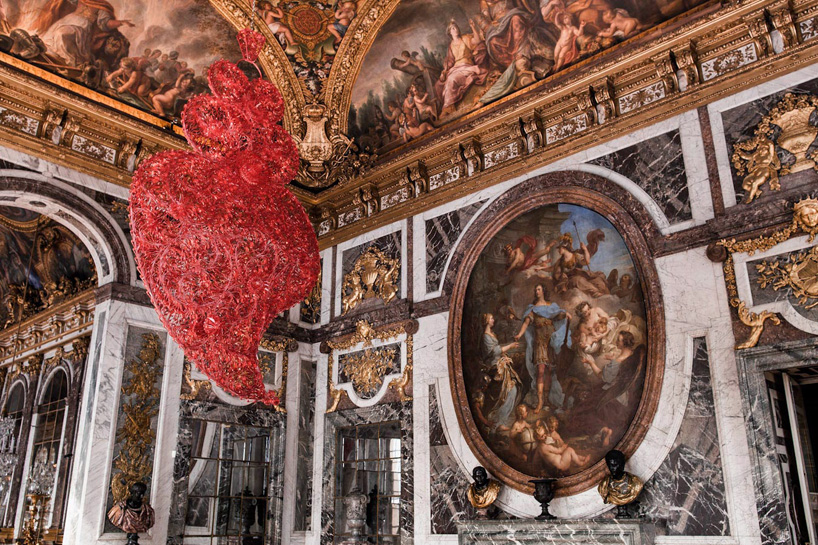 salon de la paix ‘coração independente vermelho’, 2005 [cœur indépendant rouge] translucent red plastic cutlery, painted iron, metal chain, motor, sound installation songs performed by amália rodrigues: estranha forma de vida [strange way of life] (alfredo rodrigo duarte/amália rodrigues), maldição [curse] (joaquim campos da silva/armando vieira pinto), gaivota [seagull] (alain oulman/alexandre o’neill). authorized by iplay – som e imagem / (p) valentim de carvalho. 371 x 220 x 75 cm museu colecção berardo, lisbon
salon de la paix ‘coração independente vermelho’, 2005 [cœur indépendant rouge] translucent red plastic cutlery, painted iron, metal chain, motor, sound installation songs performed by amália rodrigues: estranha forma de vida [strange way of life] (alfredo rodrigo duarte/amália rodrigues), maldição [curse] (joaquim campos da silva/armando vieira pinto), gaivota [seagull] (alain oulman/alexandre o’neill). authorized by iplay – som e imagem / (p) valentim de carvalho. 371 x 220 x 75 cm museu colecção berardo, lisbon
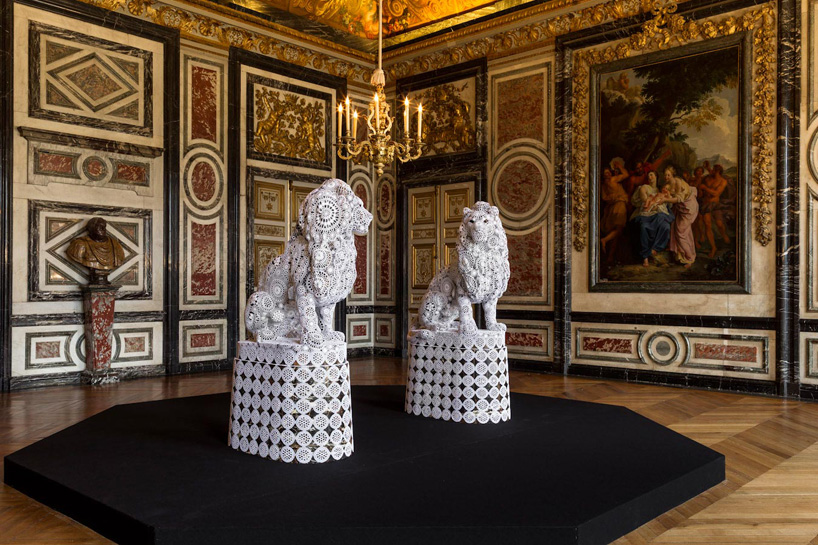 salle des gardes de la reine ‘gardes’, 2012 port laurent marble (pakistan) lions and bases, azores crocheted lace (2x) 200 x 65 x 110 cm collection of the artist; courtesy galerie nathalie obadia, paris/brussels and haunch of venison, london
salle des gardes de la reine ‘gardes’, 2012 port laurent marble (pakistan) lions and bases, azores crocheted lace (2x) 200 x 65 x 110 cm collection of the artist; courtesy galerie nathalie obadia, paris/brussels and haunch of venison, london
on the morning of 6th october 1789, the revolutionary crowd invaded the salle des gardes de la reine prior to being struck down, one of the guards managed to crack the antechamber’s door open and shout ‘sauvez la reine!’.
the same room, profusely decorated with marbles and loaded with references to absolute power – from noël coypel’s paintings dedicated to jupiter, the great god of the roman pantheon, to the bust of roman emperor vespasian – displays, side by side like sentries on a porch, two proud lions as symbols of patriarchal power. the robust bodies sculpted in precious port laurent marble sit on their respective plinths, ambiguously protected/imprisoned by a second skin of white crochet, a traditionally feminine handcraft technique.
these lions entrapped in croché tell us about power. by artfully manipulating opposites – masculine/feminine; power/subservience; strength/fragility; robustness/delicacy; imprisonment/protection; solar/lunar -, gardes forces the collapse of gender inequality and comes forth as the loyal keeper of womens’ accomplishments.
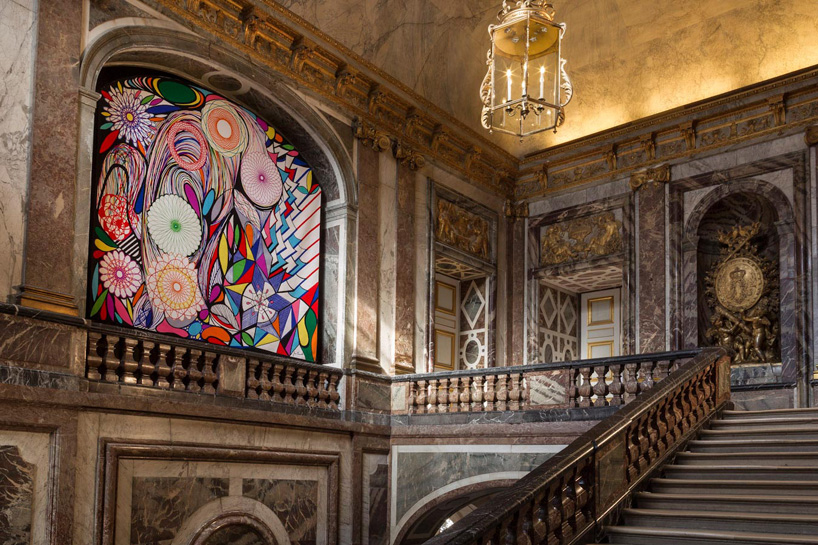 escalier de la reine ‘vitrail’, 2012 [stained glass window] wool, cotton 346 x 367 cm collection of the artist; courtesy galerie nathalie obadia, paris/brussels and haunch of venison, london work produced in collaboration with manufactura de tapeçarias de portalegre
escalier de la reine ‘vitrail’, 2012 [stained glass window] wool, cotton 346 x 367 cm collection of the artist; courtesy galerie nathalie obadia, paris/brussels and haunch of venison, london work produced in collaboration with manufactura de tapeçarias de portalegre
a large scale tapestry full of warm textures, ‘vitrail’ fills up one of the archways in the escalier de la reine, introducing a successful contrast with the cold marble surfaces.
profane or sacred, the ambiances decorated with stained glass acquire a particular spirituality, as light penetrates the coloured glass. the visual possibilities of the portalegre stitch – which owes its name to the portuguese city of the upper alentejo region, where the work was laboriously and patiently manufactured – demonstrated by the accurate interpretation of the original drawing and colours, confer the tapestry an effect resembling stained glass.
culminating in a low arch, the composition functions as an open porthole towards a cheerful, dynamic and mystical world. the turmoil of freely intersecting shapes and lines, is paired with the drawing’s vibrant colours, creating a real feast of light, colour and movement.
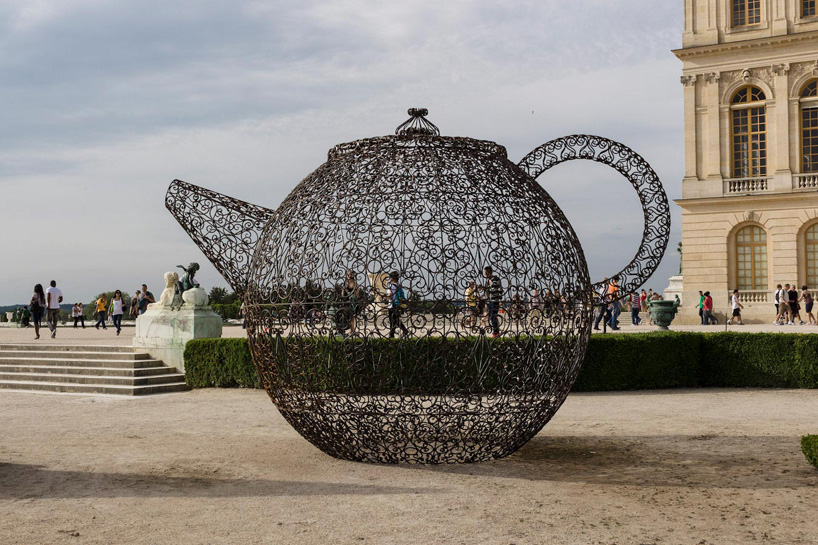 parterre du midi ‘pavillon de thé’, 2012 wrought iron, jasmine plants 359 x 509 x 345 cm 3 unique versions + 1 AP collection of the artist; courtesy galerie nathalie obadia, paris/brussels and haunch of venison, london
parterre du midi ‘pavillon de thé’, 2012 wrought iron, jasmine plants 359 x 509 x 345 cm 3 unique versions + 1 AP collection of the artist; courtesy galerie nathalie obadia, paris/brussels and haunch of venison, london
at the entrance of the parterre du midi, the visitor is greeted by two monumental wrought iron structures installed side by side: ‘pavillon de vin’, in the form of a demijohn, and ‘pavillon de thé’, shaped like a teapot.
faithful to the representation of opposites, omnipresent in versailles’s architecture and décor , the works emerge as representations of man – pavillon de vin – and woman – pavillon de thé. on the iron railings, one recognizes the typical patterns of fences and balconies. the wrought iron, a material that is simultaneously functional and decorative, becomes structural in these objects, whose domesticity is denied by the spectacular enlargement of their usual scales.
simultaneously an arbour and a sculpture, both these sculptures were conceived to accommodate plants – vines in ‘pavillon de vin’ and jasmine in ‘pavillon de thé’ – that trail up the iron structure in a harmonious combination between industry and nature. they challenge and enchant, transferring everyday life’s programmed routines into a world that is strange yet, at the same time, familiar.
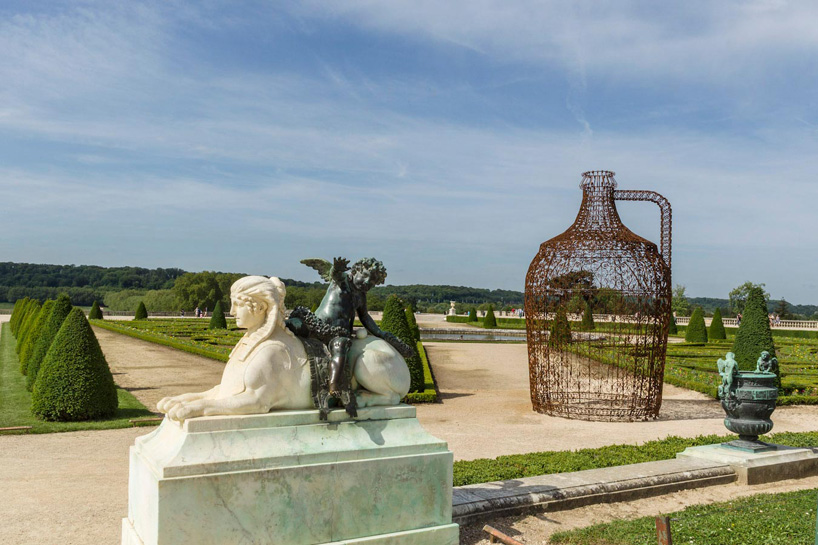 parterre du midi ‘pavillon de vin’, 2011 wrought iron, vine plants 550 x ø 330 cm 3 unique versions + 1 AP courtesy societé effi/galerie nathalie obadia, paris/brussels
parterre du midi ‘pavillon de vin’, 2011 wrought iron, vine plants 550 x ø 330 cm 3 unique versions + 1 AP courtesy societé effi/galerie nathalie obadia, paris/brussels
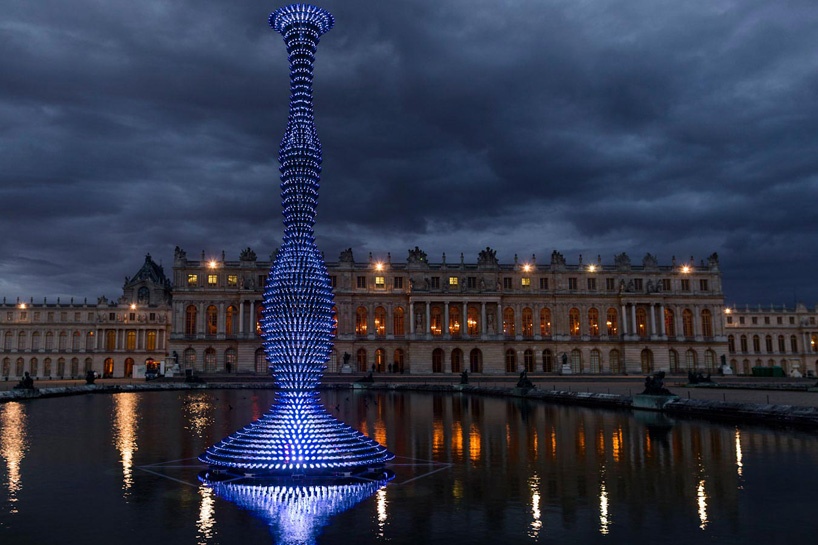 parterre d’eau ‘blue champagne’, 2012 pommery pop champagne bottles, metallized and thermo lacquered iron, ultra bright leds, electric system (2x) 940 x ø 496 cm collection of the artist; courtesy galerie nathalie obadia, paris/brussels and haunch of venison, london work produced with the support of vranken pommery’
parterre d’eau ‘blue champagne’, 2012 pommery pop champagne bottles, metallized and thermo lacquered iron, ultra bright leds, electric system (2x) 940 x ø 496 cm collection of the artist; courtesy galerie nathalie obadia, paris/brussels and haunch of venison, london work produced with the support of vranken pommery’
‘blue champagne’, a monumental work comprising two vertical twin structures and incorporating thousands of champagne bottles lit from their interior, stands on either side of the rectangular water parterres that stretch in front of the palace’s terrace. while respecting the architectural symmetry of versailles, the structures introduce a verticality that contrasts with the immense horizontal lines of the landscape. visible from inside the hall of mirrors, the two elements subvert the domestic scale of the referenced objects – candlestick holders or bottle racks –, whith their shape and architectural dimension resembling the flamboyant verticality of the late gothic.
merging the legacies of the ready-made, nouveau réalism and postmodernism, blue champagne reports to the pleasures of the table – like some of the statues of the north façade, facing the central building -, and to the process of national identification associated with gastronomy. the confrontation with marcel duchamp’s first ready-made – porte-bouteilles (1914), later presented as séchoir à bouteilles or hérisson – is openly declared, in a strategy that, in the vast territory of art history, questions the timelessness of aesthetic values and the human behavioural principles.
